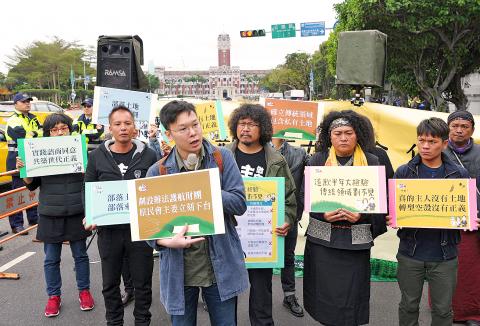Failure to include private land within the government’s legal definition of Aboriginal “traditional areas” will entrench historical oppression and injustice, Aboriginal campaigners said yesterday, blasting the government’s failure to meet its promise of transitional justice.
More than a dozen people associated with the Aboriginal Transitional Justice Classroom (原住民轉型正義小教室) gathered on Ketagalan Boulevard in front of the Presidential Office Building and shouted for villages to be allowed to declare their own traditional areas.
“Excluding private land amounts to an acknowledgement that the past behavior and policies which led to the theft of Aboriginal land were legitimate,” said Salone Ishahavut, a Bunun and a professor of indigenous development at National Chi Nan University.

Photo: CNA
She said that the 800,000 hectares which the Council of Indigenous Peoples has estimated will be covered under traditional area delineation guidelines published last week is a drastic reduction from the 1.8 million hectares it estimated should be included following a survey completed in 2007.
New guidelines restrict application of the “traditional area” label to government-owned land, explicitly excluding private land.
While it is not clear what portion of the reduction is attributable to the exclusion of private land, much of the prime real estate in traditional areas is now in private hands, Salone said.
“While this delineation of traditional areas was supposed to be about protecting our land rights, excluding privately owned land will mean the final and complete loss of original lands and their related memories,” she said.
Including privately owned land in the “traditional areas” would give Aboriginals a voice in development projects, while leaving formal ownership unchanged, she said.
“This policy is effectively saying that the system of private property can address many delicate questions and complicated processes,” said Lin Fei-fan (林飛帆), a Sunflower movement leader.
Lin said the council is using its administrative discretion to avoid tackling difficult aspects of transitional justice.
“Traditional areas should refer to the real-life space of our ancestors, but the council is focusing on the ‘status quo,’ which has already diverged from tradition. These delineation rules amount to an acknowledgement that our nation is unable to face the real history of indigenous peoples,” Amis singer-activist Panai Kusui said.
Including private land would spotlight the injustices involved in its acquisition, and could spark a national conversation, she said.
Another Amis, Mayaw Biho, a documentary filmmaker and a former head of Taiwan Indigenous TV, said the government has failed to follow through with promises to push for indigenous transitional justice in parallel with transitional justice efforts aimed at other abuses under Chinese Nationalist Party (KMT) authoritarian rule.
“The Presidential Office committee on indigenous justice held its first meeting in December [last year] and that was just an initial meeting which did not result in anything — but just look at all the Ill-gotten Party Assets Settlement Committee has been doing,” Mayaw said.

SHIPS, TRAINS AND AUTOMOBILES: The ministry has announced changes to varied transportation industries taking effect soon, with a number of effects for passengers Beginning next month, the post office is canceling signature upon delivery and written inquiry services for international registered small packets in accordance with the new policy of the Universal Postal Union, the Ministry of Transportation and Communications said yesterday. The new policy does not apply to packets that are to be delivered to China, the ministry said. Senders of international registered small packets would receive a NT$10 rebate on postage if the packets are sent from Jan. 1 to March 31, it added. The ministry said that three other policies are also scheduled to take effect next month. International cruise ship operators

NUMBERS IMBALANCE: More than 4 million Taiwanese have visited China this year, while only about half a million Chinese have visited here Beijing has yet to respond to Taiwan’s requests for negotiation over matters related to the recovery of cross-strait tourism, the Tourism Administration said yesterday. Taiwan’s tourism authority issued the statement after Chinese-language daily the China Times reported yesterday that the government’s policy of banning group tours to China does not stop Taiwanese from visiting the country. As of October, more than 4.2 million had traveled to China this year, exceeding last year. Beijing estimated the number of Taiwanese tourists in China could reach 4.5 million this year. By contrast, only 500,000 Chinese tourists are expected in Taiwan, the report said. The report

HORROR STORIES: One victim recounted not realizing they had been stabbed and seeing people bleeding, while another recalled breaking down in tears after fleeing A man on Friday died after he tried to fight the knife-wielding suspect who went on a stabbing spree near two of Taipei’s busiest metro stations, Taipei Mayor Chiang Wan-an (蔣萬安) said. The 57-year-old man, identified by his family name, Yu (余), encountered the suspect at Exit M7 of Taipei Main Station and immediately tried to stop him, but was fatally wounded and later died, Chiang said, calling the incident “heartbreaking.” Yu’s family would receive at least NT$5 million (US$158,584) in compensation through the Taipei Rapid Transit Corp’s (TRTC) insurance coverage, he said after convening an emergency security response meeting yesterday morning. National

The Forestry and Nature Conservation Agency yesterday launched a gift box to market honey “certified by a Formosan black bear” in appreciation of a beekeeper’s amicable interaction with a honey-thieving bear. Beekeeper Chih Ming-chen (池明鎮) in January inspected his bee farm in Hualien County’s Jhuosi Township (卓溪) and found that more than 20 beehives had been destroyed and many hives were eaten, with bear droppings and paw prints near the destroyed hives, the agency said. Chih returned to the farm to move the remaining beehives away that evening when he encountered a Formosan black bear only 20m away, the agency said. The bear